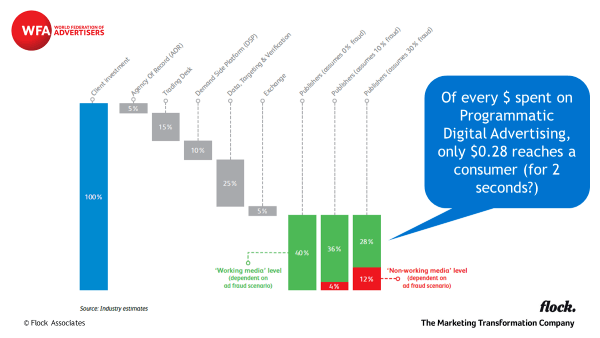Many columns have been written about the serious problems that seem to be part and parcel of placing digital advertising. Both the Association of National Advertisers (ANA) in the US, as well as the World Federation of Advertisers (WFA) have published several industry studies and papers that showcase significant issues with fraud and the budget blackhole that constitutes the many middle men in the food chain. In the worst-case scenario, of every dollar invested by advertisers, only about 0.28cts reach an actual consumer.
And that is before we take into consideration the thorny issue of ad blockers, which consumers download in large numbers, and which is being built into more and more operating system as the standard default (Apple’s latest iOS release is one such example).
Sadly, the fact that fraud is so very lucrative for the “bad guys” means that we are now living in a true arms race to ward off losing significant amounts of your digital ad budget in placing digital advertising. Each time publishers, agencies and advertisers refine their approach, the other side will find and explore new ways to skim and steal.
The challenges stretch across the complete spectrum of digital advertising, from websites to search to social and, lately, mobile.
In working with large advertisers, we find most know that these issues are significant and problematic, but they have not really addressed how they manage, place, measure and govern digital ad placement. In many cases we find that they leave the responsibility to the agency, trusting they have the tools and practices in place to safeguard the marketers digital ad investment.
But as we have learned this year, that strategy is not at all safe nor smart. Most agencies placing digital media learned early on that digital media was one of the highest margin businesses they had. And as a consequence, they significantly invested in tools and tech that helped deliver high margins to their bottom line, while ignoring or even blatantly avoiding transparency into where the digital dollars went.
Due to the heavy back lash from the WFA, the ANA, ISBA and individual advertisers such as P&G and Unilever, agencies have started to clean up their act. But as much as they are trying to turn the tide, the agency’s terms and conditions that exist in advertiser contracts are still very much stacked in favor of the agency.
And the rest of the industry, like platforms, tech middle men, publishers and other players may talk about the issues but have little incentive to actually do something. Plus, the real bad guys obviously have zero interest in disclosure, transparency or improvements and are finding ever new ways to dupe, muddle and confuse so as to not endanger their lucrative source of income.
Responding to this Flock has partnered with pre-eminent New York based digital media performance measurement and tracking firm Marketing Science and developed the Digital Health Check. The Digital Health Check does what a human health check also does: it provides a quick way to learn if there are any immediate health issues that would require attention from a specialist.
The Digital Health Check will monitor the sources and drivers of a marketers’ website for free for one month, or 100 million impressions, whichever comes first. It provides almost immediate insights that will allow marketers to optimize their media strategies and deliver the maximum amount of actual humans, and minimize the amount of fraudulent bot connections. Here is an example of how this can have a quick and positive effect on a digital campaign:
If you are interested to see how healthy your digital advertising is, contact us here






